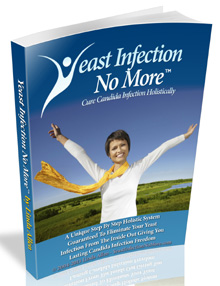Yeast Infection Remedy - Easy and Effective Herbal Treatments
Free Video Reveals 1 Weird Tip To Quickly Cure Your Candida Overgrowth & Enjoy Permanent Freedom From Yeast Infections In As Little As 12 Hours - Guaranteed!
>> Yeast Infection Guaranteed Treatment Click Here <<
Yeast is the second most common kind of vaginal infection. One of the many species of fungus called Candida causes it. Candida normally lives in small numbers in the vagina as well as in the mouth and digestive tract of both men and women.
Women are more vulnerable to get vaginal yeast infections if their bodies are under stress from poor diet, lack of sleep, illness, or when they are pregnant or taking antibiotics. Women with immune suppressing diseases such as diabetes and HIV infection are also at increased risk.
Symptoms of yeast:
The symptoms of yeast infection may vary from very mild to severe and include:
? Vaginal itch or soreness
? Thick, white, curd like discharge
? Burning discomfort around the vaginal opening, especially when urine touches the area
? Pain during sexual intercourse
? Unpleasant odour from the genitalia
? Itching and burning of the female genitals (vulva)
? Painful urination
? Vulva redness and swelling
Vaginal discharge is not always present and may be minimal, but when present may be:
? cheese like in nature
? thick, whitish-grey discharge
? watery to thick in consistency
Causes of yeast infection:
Since yeast is normal in a women's vagina, it causes an infection when a change in the balance in a woman's system occurs. For example, pregnancy, which leads to changes in hormone levels. Antibiotics can kill the normal vaginal bacteria. Then the yeast, which is usually present in or near a women's vagina can multiply.
Thus, yeast overgrowth usually occurs as the result of:
? Fatigue
? High stress
? Hormonal fluctuations during the menstrual cycle
? Increased warmth and moisture in the vaginal area
? Menopause
? Not drying the outer vaginal area thoroughly after bathing
? Birth control pills
? Poor diet
? Poorly ventilated underwear
? Poor personal hygiene
? Pregnancy
? Certain drugs
? Use of 'broad spectrum' antibiotics
? Vaginal intercourse without adequate lubrication
? Sweating
? High diabetes, which raises blood sugar levels making a conducive environment for yeast fungus to grow
Treatment of yeast infection:
Any woman who experiences symptoms of a yeast infection for the first time should visit a doctor. This is important to be sure that the vaginal discharge and discomfort is caused by yeast and not any other sexually transmitted infection.
Vaginal yeast infections are treated with antifungal medicines that are inserted directly into the vagina as tablets, creams, ointments or suppositories.
Treatment of sexual partners is not necessary, since most yeast infections are not transmitted sexually.
How to prevent yeast infection?
Every three out of four women experience at least one yeast infection during her life; many experience recurrent infections.
However, one can reduce the probability of recurrent attacks by practicing some preventive steps ?
- Always wear white cotton panties. Nylon and Lycra may trap air and create a breeding ground for yeast.
- Keep the external genital area clean and dry.
- Avoid antibiotics and steroids, because they destroy the competing bacteria and allow yeast to overgrow.
- Avoid irritating and perfumed soaps, vaginal sprays.
- Change tampons and sanitary napkins frequently.
- After swimming, change quickly into dry clothing instead of sitting in wet bathing suit for prolonged periods.
- Take antibiotics only as prescribed by a doctor.
- If diabetic, try to keep tight control over blood sugar levels.
- Avoid using oral contraceptives if you have a yeast infection.
- Avoid use of petroleum-based lubricants for vaginal lubrication during sexual intercourse. Try using water-based lubricants.
- Eating one cup of yogurt a day helps some women prevent the yeast infections that often follow antibiotic treatment. However, eating yogurt will not cure a yeast infection.
- Do not wear underwear at night, as our body needs to dry after a day of clothing which traps heat and moisture.
Dietary recommendations for yeast infection -
Any woman with a yeast infection should be particularly careful about her diet, as some foods promote fungal growth. Try to include -
? Fresh vegetables and fruits
? Fish
? Whole grains
? Essential fatty acids, such as nuts
? Plenty of fresh water
? 1 tablespoon Isabgol husk fibre and/or 1/4 cup Oat bran daily Avoid:
? Alcohol
? Animal fats
? Caffeine
? Dairy products, such as cheese, ice-cream
? Fast foods
? Pickle, vinegar or any yeast product
? Fermented food
? Hydrogenated oils and margarine
? Processed foods
? Sugar, sweets, chocolates
? White and processed flour products
Thus, as yeast fungus thrives on sugars and carbohydrates - a vegetarian nondairy diet of protein, unrefined grains, and vegetables is best. Onions and garlic are also very helpful. Fresh, raw garlic is the best. Avoid meat-based proteins.
Read More on Treatments by Ayurveda and Home Remedies at http://www.ayushveda.com
Read more about Ayurveda at World's Largest Portal on Ayurveda and Ayurvedic Remedies. - The Free Ayurvedic Encyclopedia
Labels: cause of yeast infection, home remedy for yeast infection, male yeast infection, oral yeast infection, vaginal yeast infection

